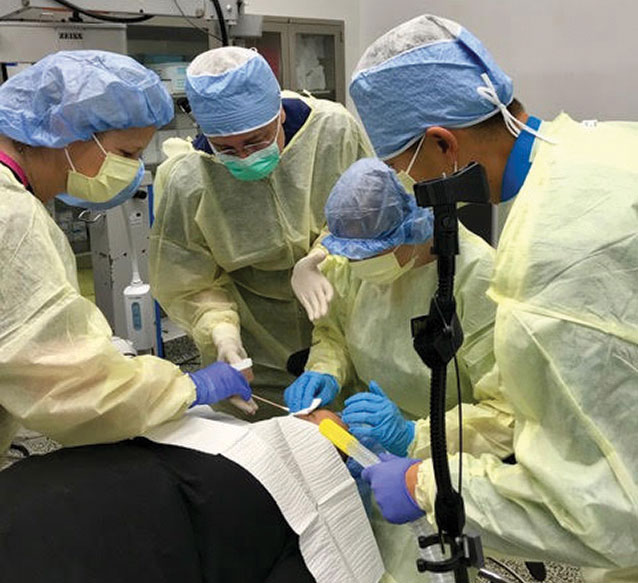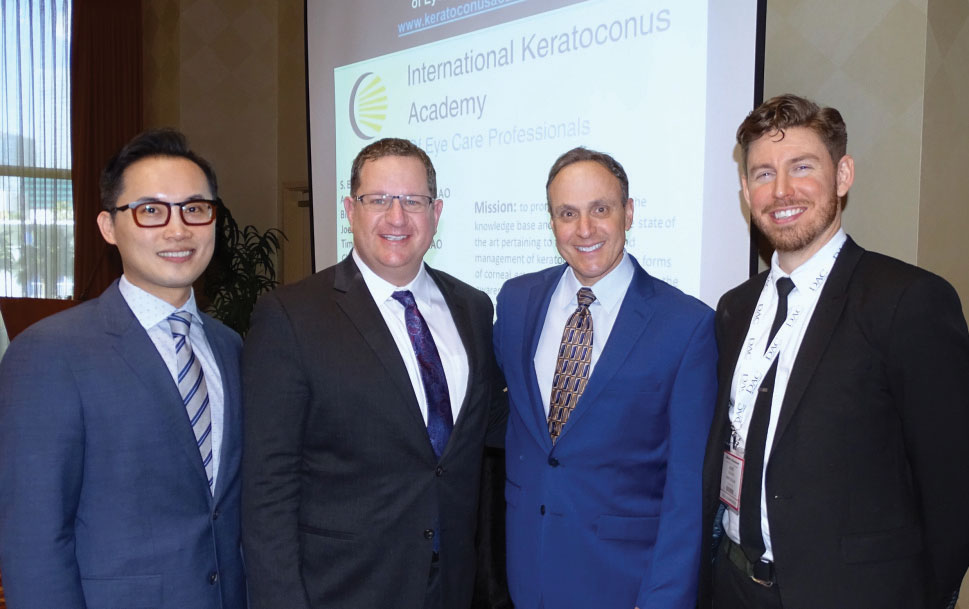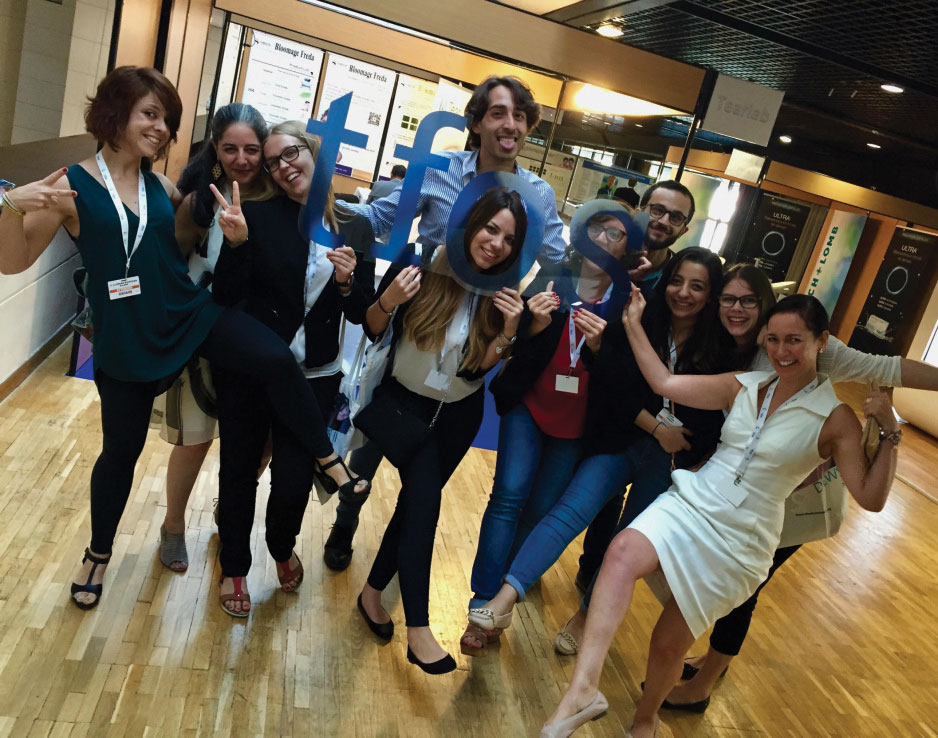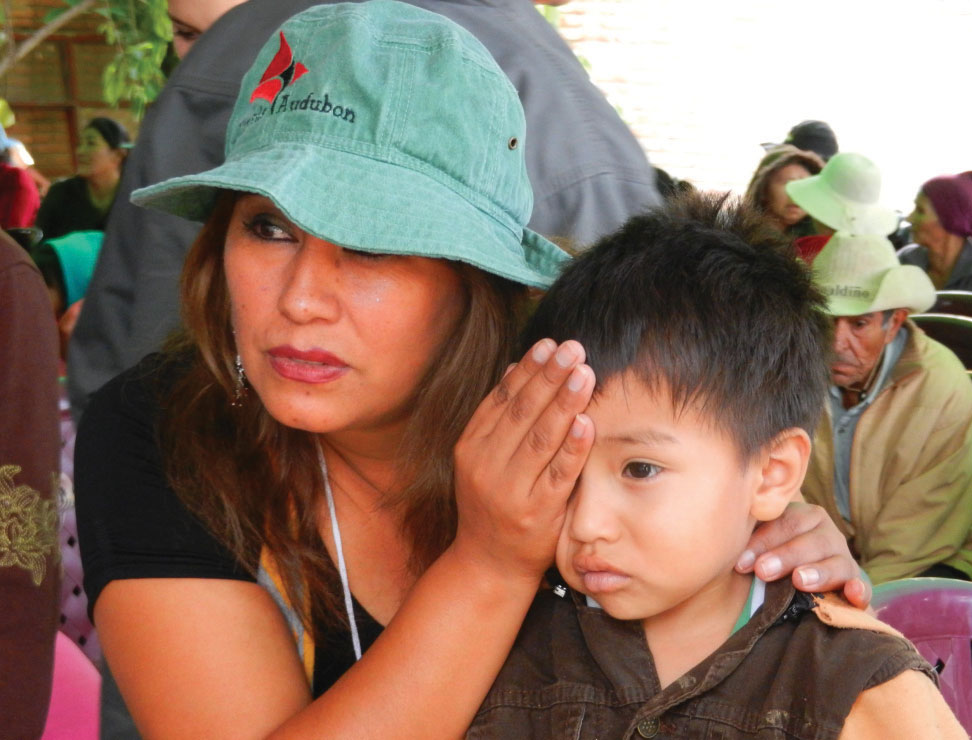It’s easy to get caught up in the swing of things, especially when you’re seeing patients back-to-back each day, but wouldn’t it be nice if you could take a little time to further your career? Well, special interest groups allow you to do just that. And there’s something for everyone—whether you’re interested in volunteering in eye clinics in underserved countries, attending study groups that discuss the direction optometry is moving or conducting breakthrough research that will advance the quality of care—you just need to know where to go to find it. Look no further!
This article gives an overview of many optometric special interest groups, complete with the information necessary to decide which one is the right fit for you.
 |
| Each fall, thousands of ODs pack the plenary session of the AAO annual conference to hear expert clinicians share their insights. |
American Academy of Optometry (AAO)
The Academy was created in 1922 to “promote the art and science of vision care through lifelong learning” and provide continuing education (CE) to optometrists and vision scientists.1 Academy members include Fellows, Candidates for Fellowship and students/residents.1 Members enjoy access to and previews of the organization’s journal, Optometry and Vision Science, discounted registration for the Academy’s annual meeting, access to past meeting recordings and handouts and opportunities to join Sections and Special Interest Groups (SIGS).1
The Academy has eight Sections that each act as a “vehicle for optometrists with interest in specialty areas to meet around particular topics,” according to Jenny Brown, MBA, CAE, director of membership and communications. These include: anterior segment; binocular vision, perception and pediatric optometry; comprehensive eye care; cornea, contact lenses and refractive technologies; glaucoma; low vision; optometric education; and public health and environmental vision.1
SIGs, on the other hand, are for “Academy members who have a special interest in areas that are too narrow to warrant a complete Diplomate program,” says Ms. Brown. These groups provide a forum for clinicians interested in academic medical centers, research, neuro-ophthalmic disorders, nutrition, disease prevention, wellness, retina, vision in aging and vision science.1 Sections and SIGs produce symposia for the Academy’s annual meeting and serve as the Academy’s resource in these particular topics, notes Ms. Brown.
“The American Academy of Optometry’s Sections and SIGs give our members a home within the Academy where they can connect, share knowledge and collaborate on a particular topic that interests them,” says President Barbara Caffery, OD, PhD.
American Optometric Association (AOA)
The AOA was founded in 1898 and bills itself as “the leading authority on quality care and an advocate for our nation’s health.”2 Doctors of optometry, legislators, patients and other professionals look to the AOA for advocacy, CE, tools to advance optometric practice and public awareness related to optometry, eye care and health care policy that serve to enhance and ensure quality patient care.2
Members have the opportunity to join AOA on Capitol Hill to discuss key issues facing the profession with legislators. Optometry’s Meeting, the AOA’s annual conference, serves as a conduit for clinical resources, CE events and networking possibilities.2 The AOA has several key initiatives that advocate for the profession and the eye health care needs of the public, including its Health Policy Institute, Keyperson Network, numerous volunteer committees and the Think About Your Eyes campaign.2
 |
| ASOS student members receive guidance on procedural technique during a workshop. Photo: ASOS |
American Society of Optometric Surgeons (ASOS)
Established in 2017, this relative newcomer provides support and resources for optometric students, physicians and educators practicing advanced optometric procedures.3
“We came together to exchange knowledge, share experiences and offer advice and guidance to practitioners seeking to further develop skill and expertise in these areas,” says Executive Director and President Richard E. Castillo, OD, DO.
The “ideal” member is “today’s optometry student, who will benefit the most from the expansion of services and the evolving scope of practice throughout their future career,” explains Dr. Castillo.
ASOS provides online educational content and hosts members-only events as well as open meetings at various venues throughout the year (e.g., SECO 2019).3 Through the organization’s online Optometric Procedures Institute, members have access to hands-on workshops to encourage procedural skill transfer and development.3
“For decades now, optometry has been transforming itself into a service- and procedure-based profession,” says Dr. Castillo. “It continues to evolve alongside the other healthcare disciplines in response to advancements in technology and the optometric and medical knowledge base.”
Those who are interested in joining can apply to either the student category or the sustaining member category, both of which require members to pay a yearly fee.3
College of Optometrists in Vision Development (COVD)
COVD was formed in 1971 to “establish a body of practitioners who are knowledgeable in functional and developmental concepts of vision and who will ensure that the public will receive continually improving vision care,” says President Christine Allison, OD. COVD members enjoy discounted pricing to the organization’s annual meeting and board certification programs as well as various other educational opportunities.4 COVD also provides a regular e-newsletter to keep members up-to-date on the latest events and organizational happenings.4
Applicants can register for one of four membership plans, each of which comes with different requirements and annual fees—associate, affiliate, vision therapist or student/resident.4
Fellowship of Christian Optometrists (FCO)
Founded in 1986, FCO—now a section of the Christian Medical and Dental Associations (CMDA)—“envisions a world where there would no longer be people in poor or developing countries who suffer from the inability to provide for their family, or in their quality of life, by not having access to preventable eye care,” says Chairman Kyle Cheatham, OD.
FCO engages in charitable mission work worldwide that combines eye care and Christian fellowship.5 The organization holds an annual national convention and regional conferences across the country.5 Members have access to CMDA ministries, online resources, CE and job placement services as well as networking, fellowship and mentorship opportunities.5
“Those who wish to use their profession in service to others can’t do it on their own,” says Dr. Cheatham. “They need support from others who have experience and professional resources. FCO is able to assist in this.”
Five membership plans are available with varying yearly fees—student, resident/fellow, practicing/academic doctor, associate or non-healthcare.5
 |
| Members of Intrepid pose for a group photo. Photo: Intrepid |
Intrepid Eye Society
In 2015, Intrepid was born with the intention of “bringing together like-minded individuals who display all the best that optometry has to offer,” says President Michael S. Cooper, OD. The organization hosts an annual meeting, is planning co-branded CE events and has a research division that will begin producing original work in the near future, according to Dr. Cooper.
“The ideal candidate illustrates the uncanny ability to educate, innovate, collaborate and socially motivate others to elevate the profession,” he says. Those interested in applying must be optometrists who have been practicing for between one and 20 years who have been nominated by two members and submit a curriculum vitae.6 The application must then be approved unanimously by the Executive Committee and a two-thirds majority of all members.6
“The chief benefit is that Intrepid is positioned to disrupt the way education is delivered in the future,” says Dr. Cooper, who adds that the group welcomes those who are ready to accept and embrace the challenges of the ever-changing educational environment.
 |
| IKA board members take a break for a photo during a lecture. Photo: IKA |
International Keratoconus Academy (IKA)
IKA was established in 2014 to raise awareness of the diagnosis and management of keratoconus and other forms of corneal ectasia.7 The organization provides education at ophthalmic meetings and in virtual environments, says President and Co-founder Barry Eiden, OD. He adds that IKA is involved in ongoing research to increase the understanding of keratoconus.
Interested applicants can register online for one of three free membership plans—eye care provider, federal eye care provider or student.7 Members enjoy access to resources on keratoconus, teleconference forums on topics related to keratoconus and discounted CE events presented by keratoconus experts from around the world.7
International Sports Vision Association (ISVA)
Advances in and a growing awareness of vision testing and training technology led to the founding of ISVA in 2014.8 The organization aims to “provide a professional association for those interested in the field of sports vision,” says Executive Director Gary Esterow.
The group’s mission is four-fold: increase awareness of the impact vision training has on athletes, advance the delivery of sports vision care, encourage the involvement of eye care providers with expertise in the field and reduce the risk of traumatic vision- and head-related injuries.8
Those interested in joining can register by membership plan—professional, associate or student/resident—and all but students/residents must pay accordingly.8 Members have the opportunity to attend the organization’s annual conference.8
“A growing body of evidence confirms that visual abilities can be strengthened and enhanced by means of appropriate visual training,” according to Mr. Esterow, who adds that this training can help all athletes achieve higher levels of performance.
National Optometric Association (NOA)
NOA came to life in 1969 during the Civil Rights Movement and “promoted optometrists of color at a time when they faced many challenges and difficulties,” says President Sherrol Reynolds, OD. “NOA is dedicated to the optometric profession, improving diversity and inclusion and service to the underserved through our mission of ‘advancing the visual health of minority populations,’” according to Dr. Reynolds. NOA helps recruit minority students into schools and colleges of optometry and supports its student branch through mentorships, scholarships, networking opportunities and job placement services, she notes.
To become a member, applicants must fill out an online application and pay the annual fee assigned to their membership category—student, regular, corporate/affiliate or associate.9 Member benefits include an annual convention, networking, CE and complimentary events and resources.9
“NOA remains committed to addressing eye health disparities through advocacy and community outreach programs to underserved communities,” says Dr. Reynolds.
Neuro-optometric Rehabilitation Association (NORA)
In 1990, a group of ODs met to share their experiences diagnosing and treating neurologically and cognitively injured and disabled patients, thus establishing NORA, according to Mr. Esterow, executive director. The group aims to increase awareness of neuro-optometric rehabilitation services, promote professional knowledge and research, and encourage an interdisciplinary approach.10
Membership is divided into five categories with different yearly fees that everyone except students/residents must pay—organization, professional, allied professional, family/survivor or student/resident.10 Members can attend annual clinical skills workshops and NORA’s annual general conference at a discounted rate.10 They also have the opportunity to join the organization’s Clinical Skills/Fellowship program to further enhance their clinical abilities and scientific knowledge.10 Members enjoy a weekly digest with news and organizational events and have access to a bimonthly email that provides advice on marketing strategies.10
Optometric Cornea, Cataract and Refractive Society (OCCRS)
Now in its 16th year, OCCRS has evolved to incorporate several advanced, rapidly developing areas within optometry, according to President David Friess, OD. “OCCRS aims to provide clinical and practice management education within optometry for clinical care of anterior segment surgical patients and related topics, such as dry eye and emerging glaucoma surgical treatments,” he says.
Members are invited to the organization’s annual CE conference at a discounted rate and have ongoing opportunities to network, obtain clinical advice and take advantage of career advancement activities.11 The organization provides a members-only email forum and hosts social gatherings for those interested in joining.11
Optometric Extension Program (OEP)
OEP, founded in 1928, started with study groups that met to discuss and spread new information in the field, says former President Paul Harris, OD. The organization now provides clinical seminars, courses and congresses of optometry that “can help take an optometrist from being a generalist to having the tools and knowledge to offer high-level, excellent-quality vision therapy in their practices,” according to Dr. Harris. OEP focuses on visual health and hygiene, visual and ocular problem prevention, visual development and rehabilitation knowledge and vision and visual process enhancement.12 Members have access to the Journal of Behavioral Optometry and the Journal of Optometry and Visual Performance.12 Enrollment is open to everyone.12
 |
| OGS members break during a meeting for a group photo. Photo: OGS |
Optometric Glaucoma Society (OGS)
OGS was created in 2002 to enhance the clinical care of glaucoma patients through education and research.13 Members have access to online resources and are invited to the society’s annual meeting, held in conjunction with the AAO’s annual meeting, which provides CE and networking opportunities.13 A subscription to the International Glaucoma Review is included with membership, according to Executive Director Kellie Rogers.
Those interested in becoming a part of OGS are required to fill out an online application, submit letters of support from two members and provide the appropriate documentation.13 Once the executive and membership committees review an applicant’s submission to determine eligibility, an affirmative vote by the majority of members is needed.13 Membership dues are $100 per year.13
Optometric Retina Society (ORS)
Founded in 2003, “ORS was created to have a forum where optometrists interested in retinal disease could get together and share ideas, cases and information,” says Immediate Past President Steven Ferrucci, OD. “In turn, we could become a source of education for the entire optometric community.”
Members enjoy complimentary e-newsletters and the opportunity to attend the organization’s annual meeting.14 The society has three categories of membership, each with minimum requirements for joining—fellow, resident/student or fellow emeritus.14 Membership is approved by the Membership Committee, president and a majority vote of fellows.14 All members, except residents/students, must pay a $150 fee every two years.14
“Through interactions, collegial discussion and the dissemination of educational materials and ideas, individuals sharing interest in this arena may find resources that improve their abilities to educate others and to serve the welfare of patients, the scientific community and their profession,” says Dr. Ferrucci.
Ocular Wellness and Nutrition Society (OWNS)
OWNS was established in 2008 for health care professionals and consumers interested in nutrition as it relates to vision and eye health.15 The $100 membership fee gives members access to organizational resources, a fellowship program and board members and affiliated experts for mentorship and clinical support.15 Members also have the opportunity to join the AAO’s Nutrition, Disease Prevention and Wellness SIG and receive discounted rates for the University of Western States’s nutrition specialist certification program and the organization’s fall symposium.15
Students can become members of chapters at several optometry schools across the country that have OWNS liaisons serving as resources, and they enjoy lower rates.15
“About half of all American adults have one or more preventable chronic diseases, many of which are related to poor quality eating patterns and physical inactivity,” according to member Julie Poteet, OD. “All of these chronic diseases have the capacity to affect ocular health. I see it as our duty as a profession to be able to not only treat ocular disease but prevent it as well.”
 |
| TFOS members do a team bonding activity. Photo: TFOS |
Tear Film and Ocular Surface Society (TFOS)
TFOS was founded on a vision Executive Director Amy Gallant Sullivan’s father had when he was in medical school. Together, the pair brought TFOS to life in 2002.
“During the past several decades, a significant international research effort has been directed toward understanding the composition and regulation of the pre-ocular tear film,” Ms. Sullivan says. TFOS hosts workshops, networking events and international conferences and creates global consensus reports and campaigns, all of which Ms. Sullivan says is to “promote the importance of eye health and the need for more research and innovation, which facilitate the actions needed to help the world see better.”
Membership is free, and benefits include access to a global community, career advice, fellowships, international events and networking opportunities.16 Members also have access to travel grants, volunteer opportunities and TFOS reports, such as the landmark TFOS Dry Eye Workshop II (TFOS DEWS II).16
“TFOS has played an important role in promoting the progress of vision research, increasing international awareness of external eye diseases, enhancing governmental funding for tear film and ocular surface research, stimulating the development of therapeutic drugs and diagnostic devices and influencing the design and conduct of clinical trials of novel treatments for ocular surface disorders,” says Ms. Sullivan.
 |
| A member of VOSH examines a child from Bolivia. Photo: VOSH |
Volunteer Optometric Services to Humanity (VOSH)
The largest all-volunteer humanitarian optometric organization in the world, VOSH was formed in 1971 to provide the gift of vision worldwide by supporting eye clinics, optometry schools and optometric educators in areas lacking sufficient eye care.17 “As the availability of optometry increases worldwide, access to care for people who currently do not have access will also increase,” says President Tracy Matchinski, OD.
Dr. Matchinski notes that anyone can join their local chapter or start a new one, adding that members pay nominal dues and participate in activities ranging from clinics to fundraising opportunities to educational events and annual meetings. The organization also offers several different programs, including VOSH Corps, the Ambassador Program, the Franklin Harms Society, the Reserves Disaster Recovery Program and the Technology Transfer Program.17
“As we help others, the people around us also become inspired,” says Dr. Matchinski. “It is a domino effect. The good of VOSH is what we do and what we inspire others to do.”
If you don’t see something that calls to you, you can always create your own special interest group. After all, each of these organizations began with one person who had an idea—and one that was shared by others. Don’t be afraid to go the extra mile and find these people and, combining collaboration and drive, transform your vision into reality to better the optometric profession.
1. American Academy of Optometry. www.aaopt.org. Accessed March 8, 2019. 2. American Optometric Association. www.aoa.org. Accessed March 8, 2019. 3. American Society of Optometric Surgeons. asos.clubexpress.com. Accessed March 8, 2019. 4. College of Optometrists in Vision Development. www.covd.org. Accessed March 8, 2019. 5. Fellowship of Christian Optometrists. cmda.org/fellowship-of-christian-optometrists. Accessed March 8, 2019. 6. Intrepid Eye Society. intrepideyesociety.com. Accessed March 8, 2019. 7. International Keratoconus Academy. www.keratoconusacademy.com. Accessed March 8, 2019. 8. International Sports Vision Association. www.sportsvision.pro. Accessed March 8, 2019. 9. National Optometric Association. nationaloptometricassociation.com. Accessed March 8, 2019. 10. Neuro-optometric Rehabilitation Association. noravisionrehab.org. Accessed March 8, 2019. 11. Optometric Cornea, Cataract and Refractive Society. www.occrs.org. Accessed March 8, 2019. 12. Optometric Extension Program. www.oepf.org. Accessed March 8, 2019. 13. Optometric Glaucoma Society. optometricglaucomasociety.org. Accessed March 8, 2019. 14. Optometric Retina Society. www.optometricretinasociety.org. Accessed March 8, 2019. 15. Ocular Wellness and Nutrition Society. www.ocularnutritionsociety.org. Accessed March 8, 2019. 16. The Tear Film and Ocular Surface Society. www.tearfilm.org. Accessed March 8, 2019. 17. Volunteer Optometric Services to Humanity. vosh.org. Accessed March 8, 2019. |

